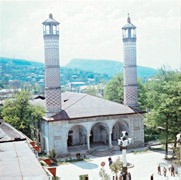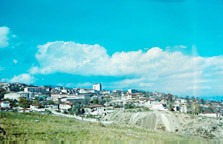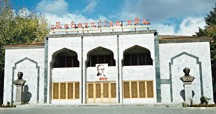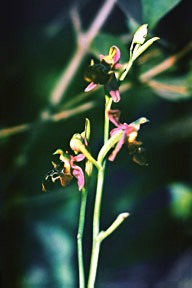|
Summer 1998 (6.2) Shusha by Jamil Alibeyli
Perhaps Panah Khan had always dreamed of naming a city after himself. Or maybe as a general, he was just tired-tired of fighting the Ottoman Turks and fed up with his boss, the Persian Shah, who had just had his brother killed. Disenchanted with military life, Panah Khan left the army, returned home to mountainous Karabakh. There Panah built a town-fortress at the top of the steep cliffs and called it Panahabad. That was in 1752. Little did he know that this fledgling fortress high up in the mountains would one day be considered one of the cultural centers of the entire Caucasus. The city came under attack a few years later when Panah Khan's son, Ibrahim Khan, was in power. Mohammad Shah of the Gajar dynasty surrounded Shusha with his Persian army. Legend says that the Shah wrote a letter in verse to Ibrahim Khan, saying: "Look, God is 'pouring stones' on your head from heaven. How can you sit in that 'glass fortress?'" What he meant was: "We're going to shatter your city to pieces, as though it were made of glass." Ibrahim Khan's self-assured answer was: "I know that God will protect me even in this 'glass.'" The city did withstand the attack; its population heroically defending it. After that, the city came to be known as "Shusha," which means "glass" in Azeri. Ibrahim Khan's majestic palace still stands today as a landmark in the city. There is also a history museum featuring the Karabakh region housed in a local mosque. During the Soviet period, many religious buildings were converted for such use. Another well-known Shusha attraction is Isa Bulaghi. "Bulag" means "source" or "spring" in Azeri. People flock to this mountain spring, especially during the summer, to relax and have picnics. The place is famous for local musicians-tar players and mugam singers-who entertain there. Conservatory of the
Caucasus Prior to the Armenian occupation, homes of several of these figures had been converted into museums. Now most of them have been closed or destroyed. Likewise, three bronze monuments dedicated to the three creative giants - Hajibeyov, Bulbul and Natavan - were discovered in Georgia, allegedly being sold for scrap metal. Azerbaijanis rescued these bullet-ridden bronze busts and brought them back to Baku where they are now on exhibit in the courtyard behind the National Museum of Art near the President's Office Building. Famous for Carpets
and Horses The Azeri people are also proud of the horses raised in the Karabakh. In Shusha, the "Jidir Duzu," (racing field) is located on top of the mountain where the view is spectacular, overlooking the Dashalti River 200 meters below. On the mountainside, there is a cave called Khazina, which means "treasury." An Azeri legend tells that a Karabakh khan once hid from his enemies in this cave. Later a tunnel was dug through the cave so that the khan and his family could escape. Shusha is quite unlike the place it used to be. Since 1992 when Azeri inhabitants fled, many houses have been burned and looted. Many stand as empty shells today. Other houses have been occupied by squatters. The minaret of the mosque has been lopped off. Museums have been closed, and monuments, carted off. Despite the devastation, Shusha's cultural legacy still lives on in the hearts and minds of the Azerbaijan people. There is considerable likelihood that, if not now, sometime in the future, Azerbaijanis will reclaim what they consider to be the city most representative of their cultural heritage. The Khari Bulbul Flower of Shusha
Khari bulbul is a very beautiful ornamental flower. In the Azeri language, "khari" means "bee" and "bulbul" means "nightingale," the bird considered to have the most melodious song. If you look closely at the flower, you'll see its close resemblance to both bird and bee. The Azeri song lyric about the "motherland garden" has given rise to the legend that the khari bulbul flower can only grow in Shusha. No matter how persistently botanists try to refute this claim, the legend persists. In the flora of the former Soviet Union, more than 10 species of this perennial plant have been identified-Latin, genera Epilobium L. The plant is used in traditional medicine of Azerbaijan. In the minds of Azeris, the Khari Nulbul represents Shusha, the beautiful mountainous town that is now "missing" from the garden of Azerbaijan. They yearn for the day that it can be "replanted," and all Azeris who had to flee Shusha (1992), and who now live as refugees, can once again return home. For more information on the
musical families that came from Shusha, see our article "Music
Runs in the Family," (AI 5.4, Winter 1997). |




